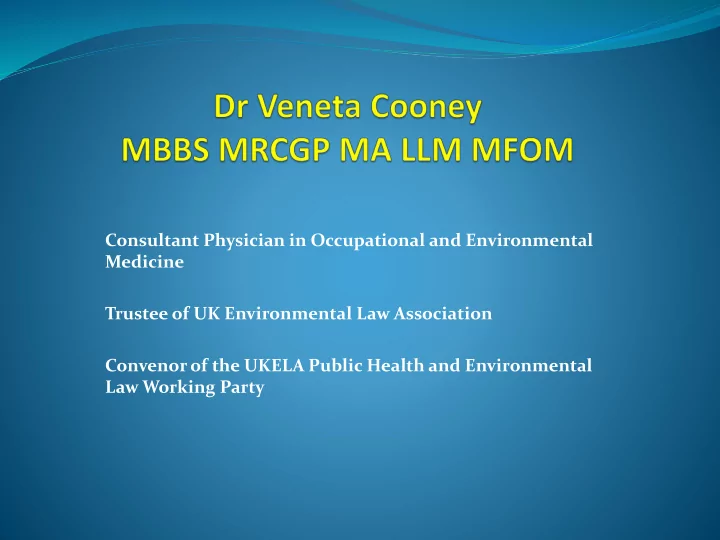

Consultant Physician in Occupational and Environmental Medicine Trustee of UK Environmental Law Association Convenor of the UKELA Public Health and Environmental Law Working Party
Protecting the environment in the public interest is all in the mind
How are we doing? Statistics are deeply depressing Knowingly destroying the environment upon which we depend Present trajectory leading to ecological collapse Air pollution/climate change is an existential threat
Why are we doing so badly?
Why are we doing so badly? Cognitive dissonance
Why are we doing so badly? Cognitive dissonance Aesthetic familiarity
Why are we doing so badly? Cognitive dissonance Aesthetic familiarity Disconnection from nature in a digital age
Why are we doing so badly? Cognitive dissonance Aesthetic familiarity Disconnection from nature in digital age Health and environment paradox
Health and environment paradox Life feels so good when nature feels so bad Examples: Cheap plentiful food Cheap plentiful energy Cheap clothes Cheap credit Cheap flights Free education Free health care Never lived so long Plethora of positive health net gains
Psychological drivers of the health and environment paradox Confirmation bias: Our beliefs come first Climate change is not real Pesticides do not cause decline in pollinators Barack Obama is not American Compensatory control: Third party responsibility Trump will make America great again The State will look after me in my old age The NHS will sort out my health prob lems
What can be done to improve matters? We need to reverse public apathy and de-ossify political sclerosis To facilitate the seismic shift in behavioural and attitudinal change towards the environment
Overall key psychological drivers required Environmental harm is a social justice issue Environmental protection is a moral duty
Psychology of caring enough to act Develop a visceral connection with the environment Behaviour and attitude resultant of emotions and not critical analysis Personify scientific data: real life examples
Reversal of the health and environment paradox Environmental protection must be part of the social justice model for health care provision
Environmentally-related illness Asthma Lung cancer Alzheimer’s disease Neuro-developmental delay Cardio-vascular disease Congenital abnormalities Psychiatric and psychological disorders
Environmentally-related illness Truly non discriminatory
Environmentally-related illness COSTS A FORTUNE!
Role of science and medical profession Communication is key because: The science of environmentally-related illness is complex
The science is complex
Role of the law “overriding public interest ” (large infrastructure projects) “Prejudicial to health” (s.79 EPA 1990) “assessment of health effects” (EIA Regulations 2017)
Key points: Appealing to people’s sense of wonder is not working Change in narrative is required Public health is the trigger for behavioural and attitudinal change towards the environment Knowledge is not enough: need to speak the language of those listening Environmental harm is a social justice issue Environmental protection is a moral duty
Protecting the environment in the public interest is all in the mind Thank you for listening Dr Veneta Cooney Consultant Physician in Occupational and Environmental Medicine Trustee of UKELA Convenor of the Public Health and Environmental Law Working Party veneta.cooney@btconnect.com
Recommend
More recommend